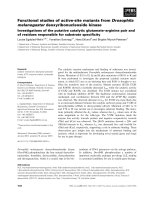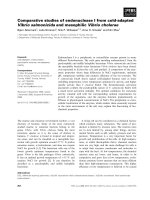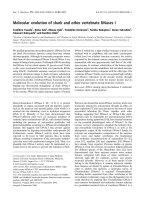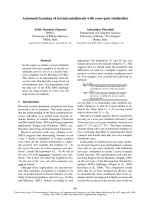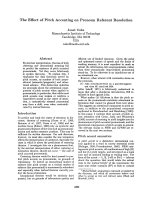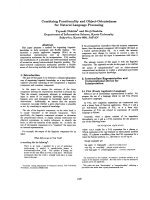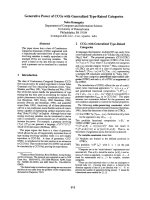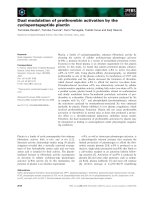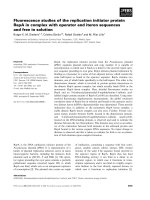Báo cáo khoa học: "EMPIRICAL STUDIES OF DISCOURSE REPRESENTATIONS FOR NATURAL LANGUAGE INTERFACES" ppt
Bạn đang xem bản rút gọn của tài liệu. Xem và tải ngay bản đầy đủ của tài liệu tại đây (840.13 KB, 8 trang )
EMPIRICAL STUDIES OF DISCOURSE REPRESENTATIONS
FOR NATURAL LANGUAGE INTERFACES
Ntis Dahlb~ick Ame JOnsson
Natural Language Processing Laboratory
Department of Computer and Information Science
LinkOping University, S-581 83 LINKOPING, SWEDEN
Intemet: ,
Phone +46 13281644, +46 13281717
ABSTRACT
We present the results from a series of ex-
periments aimed at uncovering the discourse
structure of man-machine communication in nat-
ural language (Wizard of Oz experiments). The
results suggest the existence of different classes
of dialogue situations, requiring computational
discourse representations of various complexity.
Important factors seem to be the number of dif-
ferent permissible tasks in the system and to what
extent the system takes initiative in the dialogue.
We also analyse indexical expressions and espe-
cially the use of pronouns, and suggest a psy-
chological explanation of their restricted oc-
currence in these types of dialogues.
INTRODUCTION
Natural Language interfaces will in the fore-
seeable future only be able to handle a subset of
natural language. The usability of this type of in-
terfaces is therefore dependent on finding subsets
of natural language that can be used without the
user experiencing inexplicable "holes" in the sys-
tem performance, i.e. finding subsets for which
we can computationally handle complete
linguistic and conceptual coverage. This points to
the need for theories of the 'sublanguage' or
'sublanguages' used when communicating with
computers (Kittredge and Lehrberger, 1982). But
unfortunately: "we have no well-developed lin-
guistics of natural-language man-machine com-
munication." (von Hahn, 1986 p. 523)
One way of tackling this problem is to sim-
ulate the man-machine dialogue by letting users
communicate with a background system through
an interface which they have been told is a natural
language interface, but which in reality is a per-
son simulating such a device (sometimes called a
Wizard of Oz experiment, see Guindon, Shuld-
berg, and Conner, 1987). While not being a new
technique, early examples are Malhotra (1975,
1977), Thomas (1976), and Tennant (1979,
1981), only a limited number of studies have
been conducted so far. A considerably larger
number of similar studies have been conducted
where the users knew that they were communi-
cating with a person. This is unfortunate, since
those researchers who have considered the issue
have noted that the language used when commu-
nicating with a real or simulated natural language
interface has differed from the language used in
teletyped dialogues between humans, although it
has been difficult to the exact nature of these dif-
ferences. The language used has been described
as 'formal' (Grosz, 1977), 'telegraphic'
(Guindon et al, 1987), or 'computerese' (Reilly,
1987).
Only a few Wizard of Oz studies have been
run, using different background systems and dif-
feting in questions asked and methods of analysis
used. It is therefore premature to draw any far-
reaching conclusions. With some caution, bow-
ever, perhaps the following can be accepted as a
summary of the pattem of results obtained so far:
The syntactic structure is not too complex
(Guindon et al, 1987, Reilly, 1987), and presum-
ably within the capacity of current parsing tech-
nology. Only a limited vocabulary is used
(Richards and Underwood, 1984), and even with
a generous number of synonyms in the lexicon,
the size of the lexicon will not be a major stum-
bling block in the development of an interface
(Good, Whiteside, Wixon, and Jones, 1984).
However, it is unclear how much of this vocabu-
lary is common across different domains and
different tasks, and the possibility of porting such
a module from one system to another is an open
question. Spelling correction is an important fea-
ture of any natural language based system. So-
called ill-formed input (fragmentary sentences, el-
lipsis etc) is very frequent, but the use of pro-
nouns seems limited (Guindon, et al, 1987, J0ns-
son and Dahlb/~ck, 1988).
,However, the results concerning ill-formed-
ness are difficult to evaluate, mainly because they
are often presented without an explicit description
of the linguistic representation used. An utterance
can obviously only be ill-formed relative to a
formal specification of well-formedness. With
some hesitation the exclusion of such a specifi-
cation can perhaps be accepted as far as syntax is
- 291 -
concemed. Both linguistic theory and our lin-
guistic intuitions are adequately developed to
guarantee some consensus on what counts as un-
grammatical (though the
written language bias in
linguistics
(Linell, 1982), i.e. the tendency to re-
gard the written language as the norm, and to
view other forms as deviations from this, has in
our opinion lead to an overestimation of the ill-
formedness of the input to natural language in-
terfaces also in this area). But when it comes to
dialogue aspects of language use, we lack both
theory and intuitions. What can be said without
hesitation, however, is that the use of a connected
dialogue, where the previous utterances set the
context for the interpretation of the current one, is
very common.
It is therefore necessary to supplement previ-
ous and on-going linguistic and computational re-
search on discourse representations with empirical
studies of different man-computer dialogue situa-
tions where natural language seems to be a useful
interaction technique. Not doing so would be as
sensible as developing syntactic parsers without
knowing anything about the language they should
parse.
Other researchers have proposed the use of
field evaluations as they are more realistic. How-
ever, doing so requires a natural language in-
terface advanced enough to handle the users lan-
guage otherwise the evaluation will only test the
NLI's already known limitations, as shown by
Jarke, Turner, Stohr, Vassilou & Michielsen
(1985).
METHOD
We have conducted a series of Wizard of Oz
experiments. There are two important aspects to
consider when developing the experimental situ-
ation. The first concerns the background system.
It should in our opinion be something that could
run on a computer using the technology of today
or at least tomorrow m to ensure that the in-
fluence of the situation does not invalidate the use
of data and results when developing a natural
language interface. Great care should also be
given to the design of the
scenario,
i.e. the task
given to the subjects. Obviously, any simple task
which only requires a few interactions between
user and system will not give us much data to
analyze. Our experience shows that one should
either give the subjects a task for which there does
not
exist a single correct answer, but where the
subjects own preferences determines what counts
as a satisfying goal, or by having a task where
there exists more than one way to achieve the
goal.
When conducting a Wizard of Oz experiment it
is important to ensure that the subjects believe
they are using a computer. To achieve this we
have developed an experimental environment with
a number of tools. The use of windows gives
easy access to all relevant systems.The 'wizard'
has at his disposal windows monitoring the user,
the background system, an editor and windows
with parsers or other modules developed for the
current application. Menus with prestored
(partial) answers guarantee a consistent, fast out-
put with a 'computerized' quality (Dahlbtick and
Jtnsson, 1986).
Generalizability of results requires experiments
with a variety of background systems, scenarios
and many subjects. We have used five different
scenarios for five background systems of varying
complexityl; one library database used at our de-
partment and four simulated advisory systems:
one student advisory system; one wine selection
advisory system and two advisory-and-order
systems m one for HIFI equipment and one for
travel. We have collected dialogues from 21 sub-
jects. Approximately half of them were students.
The subjects' previous experience with computers
were limited or nonexistent.
THE DISCOURSE MODEL
The collected corpus should be analyzed with
an explicit formalism in mind. Our goal is not to
develop a general discourse model, but instead to
find the simplest possible usable model for natural
language interface applications (or some subclass
of such applications).
The interface consists of three modules. One
resembles a question-answering system without
any dialogue handling capabilities. This will
transform the user input into the appropriate
query-language command or other background
system input, given that enough information is
available in the user's utterance. Another
(linguistic context) module is used when the input
does not contain enough information to form a
1This figure does not include pilot studies. We
have recently conducted experiments using a
combined graphical and NL calendar booking system.
Since this communication situation differs from the
others, we have excluded these data from the present
analysis.
- 292
-
command to the background system. This module
uses the immediate linguistic context, i.e. the
user's and the system's last utterance, and tries to
complete the fragmentary input. Simple forms of
indexicality will be handled here, e.g. ellipsis and
pronouns that can be resolved by available sur-
face structure linguistic information. The third
module uses a case-frame like representation of
the current discourse domain (task) 1. Here
utterances whose interpretation requires
background knowledge can be interpreted. One
consequence of the use of this latter module is that
it is necessary to specify the task structure of the
discourse domain in advance of the analysis. This
approach differs from linguistically oriented
approaches to discourse analysis, where the task
structure of the dialogue is found through the
linguistic analysis.
ANALYSIS CATEGORIES
We divide our utterances into four different
categories (c.f. LineU, Gustavsson and Juvonen,
1988): 1) Initiative means that one of the par-
ticipants initiates a query. 2) Response is when
a participant responds to an initiative, such as an
answer to a question. 3) Resp/Init is used when
a new initiative is expressed in the same utterance
as a response. Typical situations are when the
system has found an answer and asks if the sub-
ject wants to see it. The utterance type 4) Clari-
fication is used in reply to a Response of type
Clarification request and indicates what type of
clarification is used. Jtnsson and Dahlb~tck
(1988) describe and discuss the analysis cate-
gories in more detail.
Task and Context
Initiatives are analyzed ("tagged") for
Context
Dependence
which concems the
interpretation
of
an utterance. We tag an utterance Context De-
pendent if it cannot be interpreted without infor-
mation in the immediate context. Every utterance
that is complete enough to be interpreted without
context is tagged Context Independent, regardless
of the possible existence of a usable context in the
previous utterance. Initiatives are tagged
Task
Dependent
if background knowledge is required
for their interpretation.
1 We use the term Task in this paper. The notion
is similar to
what we previously called Topic
(Dahlback and JOnsson 1988, JOnsson and Dahlbltck
1988).
Indexicality
We tag our Context Dependent utterances for
indexicality using three main categories: pronoun,
ellipsis and definite description. It is important to
note that there is a difference between these types,
since they vary in their dependence of a specific
theory or discourse representation model. What
counts as a pronoun can be determined lexicaUy,
and presents no major problem. But what counts
as an ellipsis is dependent on the grammar used in
the analysis, and to count a definite description as
context dependent simply because there exists
something in the previous text that could be seen
as its antecedent seems somewhat dubious. In our
opinion such an utterance should be called context
dependent only if knowledge of the preceding
linguistic context is necessary for finding its ref-
erent in the discourse representation, i.e. that the
antecedent is necessary for determining the refer-
ent. And this is obviously dependent on the qual-
ities of the discourse representation and the pro-
cess working on it.
Tagging a
pronoun is
usually straightfor-
ward, but there are some utterances which are
ambiguous. For instance, the Swedish pronoun
det (it)
may act as an anaphoric pronoun or as a
formal subject in various types of constructions,
e.g.Traveh1:26 What does it cost? 2 [Vad kostar
det?].
This is a question to a previous response
suggesting a hotel to live
in.
The
it
in Travel: 1:26
can be interpreted either as pronoun referring to
the hotel, or it can be a formal subject and then
the utterance is elliptical. There are five utterances
tagged ambiguous (all from the travel dialogues)
and they are not included in the results.
Definite descriptions are definite NP's or
other definite referents like demonstratives,
e.g.
HiFi:l:5 What is the price for a complete hifi
system with these models.[Vad blir priset fi~r
en komplett hifi-anldggning med dessa rood.
eUer.l.
Proper names are not tagged as definite
descriptions.
Ellipsis is
a problematic category, cf. above.
Our basic criterion is semantic incompleteness,
thus one word phrases, except for some impera-
2All examples are
from our corpus. The first field
indicate the dialogue, the second subject and finally
utterance number. The bold face does not occur in the
dialogues.
The corpus
is in Swedish and
translated
into English striving
for verbatim
rather than
idiomatic correctness.
- 293 -
fives and expressives (Yes, Help, Thanks etc), are
tagged ellipsis e.g. C line:4:5 prerequisites?
[fOrkunskaperl as response to a list of courses.
We also use ellipsis for comparative constructions
without expression of the comparative object e.g.
Wines:4:9 Is there any cheaper white wine [Finns
det migot billigare vitt vin].
However, in spite of the fact that we have not
used an explicit grammar, we have also regarded
syntactic incompleteness as a ground for tagging
an utterance elliptical. Certain questions like
HiFi:3 :12 price sondek [pris sondek] are tagged
elliptical for syntactic reasons. On the other hand
imperative utterances like HiFi:3 :28 Order Sondek
[Best~ll Sondek] are not tagged context dependent
and thus not indexical at all. This might seem
inconsequential, but is in fact a reflection of the
characteristics of our assumed grammar.
RESULTS AND DISCUSSION
There are 1047 utterances in our corpus. Of
these, 38% are Initiatives, 48% Responses, 10%
Resp/lnit, and 4% Clarifications. Table 1 and 2 in
the appendix summarize some of our results. 58%
of the Initiatives are Context Independent, i.e. ut-
terances that can be interpreted in isolation.
However, of these about 10% are dialogue open-
ings. This means that only 48% of the Initiatives
within the dialogues can be interpreted in isola-
tion.
Context Dependencies
The complete set of data concerning the num-
ber of context dependent utterances and the dis-
tribution of different types of context dependency
are presented in the appendix. While we believe
that the data presented here give a correct overall
picture of the qualities of the language used in the
dialogues, the previously mentioned caveat con-
ceming the theory dependency of the data, espe-
cially as regards ellipsis and definite descriptions,
should be kept in mind. We will for the same rea-
sons in this paper concentrate our discussion on
the usage of pronouns in the dialogues.The
number of Context Dependent utterances are 167
or 42%. Thus, when the users are given the op-
portunity to use connected discourse, they will w
even when the response times (as in our case) oc-
casionally seem slow.
The most common forms of indexicality are
ellipsis (64%) and definite descriptions (29%).
The use of pronouns is relatively rare, only 16%.
The limited use of pronouns is not something
found exclusively in our corpus. Similar results
were found by Guindon et al (1987), where only
3% of the utterances contained any pronouns.
While being to small an empirical base for any
conclusive results, this does suggest that the use
of pronouns are rare in typed man-computer di-
alogues in natural language. Some suggestions
why this should be the case can be found in a
study by Bosch (1988) on the use of pronouns in
spoken dialogues. He argues for a a division of
the focus structure into two parts, explicit and
implicit, and claims that "explicit focus is typi-
cally, though not exclusively, accessed by means
of unmarked referential expressions (typically de-
accented anaphoric pronouns), while implicit
pronouns focus is accessed only by marked de-
vices, including accented pronouns"(Bosch,
1988, p 207). What is interesting with this anal-
ysis in the present context, is that para-linguistic
cues (accent) is used to signal how the pronoun
should be interpreted. Since this communicative
device is absent in written dialogues, this could
explain why the subjects refrain from using pro-
nouns.
We believe this to be an expression of a gen-
eral principle for the use of pronouns. Since a
pronoun underspecifies the referent compared to a
definite description, there is every reason to be-
lieve that language users following Grice's
(1975) cooperative principle should only use
them when the listener/reader effortlessly can
identify the intended referent. This is supported
by data from Fraurud (1988), who analyzed the
use of pronouns in three different types of unre-
stricted written Swedish text. She showed that for
91% of the 457 singular pronouns a very simple
algorithm using only syntactical information
could correctly identify the antecedent, which in
97.4% of the cases were found in the same or
preceding sentence. Similar results have also been
obtained by Hobbs (1978).
We obtained results similar to those of Fraumd
(1988) as regards the distance between the
pronoun and its antecedent. All our antecedents
where found in the immediate linguistic context,
except for one problematic category, the pronoun
man (one/you), excluded in her study which often
refers to some global context, e.g. C line:5:lO
Does
one
read mechanics [Ldser man mekanik].
We will by no means conclude from this that it
is a simple task to develop a computational dis-
course representation for handling pronouns. As
pointed out by Shuster (1988), it is often unclear
whether a pronoun refers to the whole or parts of
a previously mentioned event or action. While
this underspecification in most cases seems to
- 294-
present no problems for human dialogue partici-
pants, it certainly makes the computational man-
agement of such utterances a non-trivial task.
Task structure
The results concerning task structure are in-
teresting. It is perhaps not too surprising that the
task structure in a data base application is simple.
Here one task is introduced, treated, finished, and
dropped; and then another is introduced. A
basically similar pattern is found in the advisory
systems.
The advisory-and-order systems, however,
shows a completely different picture. These sys-
tems are in an important sense more complicated,
since two different types of actions can be per-
formed; obtaining information or advice, and or-
dering. The collected dialogues show that these
two tasks are executed in parallel, or rather that
they are intertwined. The consequence is that we
have two active tasks at the same time. For in-
stance, in the HIFI simulations the interlocutors
shift rapidly between discussing the ordered
equipment, its total price, etc, and discussing
technical information about available equipment.
7% of the initiatives are task shifts in this sense.
The problem is, that while it presents no difficulty
for the human reader to follow these task shifts, it
is difficult to find any surface cues indicating
them. The computational mechanisms for han-
dling this type of dialogue will therefore presum-
ably be more complex than for the other applica-
tions that we have studied. In our opinion this
confirms Grosz' (1977) observation that there are
different types of dialogues with different task
structure. It also indicates that categories such as
data base and expert systems are not always the
most relevant when discussing application areas
for NL-techniques.
System initiatives
The system's linguistic behaviour seems to in-
fluence the language used by the user in an im-
portant sense. The utterance type Resp/Init re-
fleets how often the system not only responds to
an initiative, but also initiates a new information
request. This is used more frequently in three
simulations. This ought to result in the number of
Context Dependent initiatives being lower than in
the other dialogues, because the user has here al-
ready provided all the information needed. This
hypothesis is corroborated in two of the three
simulations (PUB and Wines). They have 17%
respective 29% context dependent initiatives
compared to the average of 42%. (We do not tag
whether a response is context dependent or not.)
The result is interesting, because it indicates that
this is a way of 'forcing' the user to use a lan-
guage which is computationally simpler to ban-
die, without decreasing the habitability of the
system, as measured in the post-experimental
interviews.
As mentioned above, this pattern is not found
in the third system, the travel advisory system.
This system belongs to the advisory-and-order
class. We cannot at present explain this differ-
ence, but would still claim that the result obtained
is interesting enough to deserve a
thorough
fol-
low-up, since databases and advisory systems
presently are the largest potential application areas
for NLIs.
Indirect speech acts
Indirect speech acts (Searle, 1975) have been
one of the active areas of research in computa-
tional linguistics. It can perhaps be of interest to
note that there are only five indirect speech acts in
our corpus, all of which use standardized ex-
pressions (Can you tell me ? etc). Beun and
Bunt (1987) found a higher frequency of indirect
requests in their corpus of terminal dialogues
(15%). However, this frequency was consider-
ably lower than in their control condition of tele-
phone dialogues (42%). Taken together, these
results seems to support our belief that some of
the reasons for using indirect means of expression
does not exist in man-computer dialogues in
natural language (c.f. Dahlb~lck and JOnsson,
1986).
The lack of variation in the expression of in-
direct speech acts is perlaaps not all that surprising
when viewed in the light of psychological re-
search on their use. Clark (1979) expanded
Searle's (1975) analysis by distinguishing be-
tween convention of means and convention of
forms for indirect speech acts; the former covers
Searle's analysis in terms of felicity conditions
and reasons for performing an action, the latter
the fact that can you open the window? is a con-
ventional form for making an indirect request,
whereas Is it possible for you to open the win-
dow? is not. Gibbs (1981, 1985) demonstrated
then that what counts as a conventional form is
dependent on the situational context in which it
occurs. There is therefore in our opinion good
reasons to believe that indirect speech acts can be
handled by computational methods simpler than
those developed by Perrault and co-workers,
something which in fact seems compatible with
the discussion in Perrault and Allen (1980). In
conclusion, we believe that indirect speech acts
are not as frequent in man-computer dialogues as
~-U - 295 -
in human dialogues, and that most of them use a
small number of conventional forms which sug-
gests that computationally tractable and cost-ef-
fective means of handling them can be found.
Task and dialogue structure
When developing N-L-technology, it is impor-
tant to try to assess the applicability domain of a
system. As mentioned above, the major dividing
line between different classes of systems in our
corpus seems not to be between database and ex-
pert (advisory) systems. But there are important
differences between these and the third class used
in this study, the advisory-and-order systems. In
these cases more than one task can be performed,
asking for information and giving an order. This
means not only that the discourse representation
needs to be more complicated, which in turn
causes problems when trying to find the referent
of referring expressions, but that it becomes nee-
essary to understand the iUocutionary force of the
utterance. As was shown in the Planes system
(Waltz 1978) when all the user can do with the
system is to request information, all input can be
treated as questions, thus simplifying the analysis
of the input considerably. But this is of course
not possible in these cases. The problem this
causes becomes especially clear in dialogues
where the user follows Grice's quantitative
maxim as much as possible, something which
occurs in some of our HiFi dialogues, where one
or two word utterances are very common. From a
communicative point of view this is a very natural
strategymif one is engaged in an information
seeking dialogue sequence requesting information
about the price of different tuners, there is no
need to say anything more than the name of one
of them, i.e. specify the referent, but taking the
illocutionary force and the predicate to be given.
And when one is satisfied with the information,
and wants to order the last one, why say some-
thing more than order, i.e. only specify the illo-
cutionary force? What makes this problematic is
of course that in some cases what is ordered is
not only the last mentioned item, but a number of
them, namely the set defined by the last men-
tioned tuner, amplifier, turn-table and loudspeak-
ers. But realizing this requires knowledge of what
constitutes as HiFi set.
Without pursuing the examples further, we
wish to make two comments on this. The first is
that delimiting the classes or subsets for which
NL-technology with different capabilities are
suitable seems to depend more on the task situa-
tion than on the computer technology of the back-
ground system. The second
is that
since the
communicative behaviour described in the previ-
ous section can be seen to be in accordance with
established theories of dialogue communication,
and since it, in spite of the terseness of the utter-
ances, seems to present no problems to the human
dialogue participants, it seems somewhat strange
to classify such utterances as ill-formed or in
other ways deviant, something which is not
uncommon. Chapanis (1981, p 106) claims that
"natural human communication is extremely un-
ruly and often seems to follow few grammatical,
syntactic and semantic rules". And Hauptman and
Rudnicky (1987, p 21) takes this to be supported
by Grosz (1977) "whose protocols show incom-
plete sentences, ungrammatical style, ellipsis,
fragments and clarifying subdialogues". Perhaps
these examples demonstrate an extreme form of
the written language bias, but in our opinion any
analysis showing that a large part of a commu-
nicative event breaks the rules of communication
should lead to a questioning of the validity of the
formulated rules. Perhaps present day analysis of
the structure of language in dialogues (including
our own) is too much influenced of the traditional
linguistic analysis of isolated utterances, and a
shift of perspective is required for a breakthrough
in this area.
A FINAL REMARK
As can be seen in the tables in the appendix,
there are differences between the different back-
ground systems, for instance the use of pronouns
in the PUB dialogues is as frequent as the use of
ellipsis, while Wines have no pronouns. There
are also differences between different users,
ranging from very condensed one word phrases
to small essays on two to three lines. This indi-
cates that when designing a NLI for a specific
application it is important to run simulations,
preferably with the real end users (cf. Kelly 1983
• and Good
et al
1984). We intend to proceed in
that direction and develop a method for design
and customization of NLI's based on Wizard of
Oz experiments.
AC KNOWLEDGEMENTS
We thank all our friends at NLPLAB for cre-
ating an intellectually and socially rewarding en-
vironment. Special thanks to Lars Ahrenberg for
comments on an earlier version of this paper.
Beret Nilsson has implemented the ARNE-2 ex-
perimental environment. Ulf Dahl6n and Ake
Pettersson have implemented the tagging system
DagTag used in the analysis. We also thank our
students for their work with the data collection.
- 296 -
REFERENCES
Beun, R.J. and Bunt, H.C. (1987) Investi-
gating linguistic behaviour in information dia-
logues with a computer. In: IPO Annual Progress
Report
Bosch, Peter (1988) Representing and Ac-
cessing Focused Referents, Language and Cog-
nitive Processes, 3, 207-231.
Chapanis, A (1981) Interactive Human Com-
munication: Some lessons learned from lab-
oratory experiments. In: B. Shackel (ed.) Man
Computer Interaction: Human Factors Aspects of
Computers and People. Rockville, MD:Sijthoff
and Nordhoff.
Clark, Herbert, H. (1979) Responding to in-
direct speech acts,Cognitive Psychology,11, 430-
477.
Dahlb~ick, N. & J0nsson, A. (1986), A Sys-
tem for Studying Human Computer Dialogues in
Natural Language, Research Report, Department
of Computer and Information Science, LinkOping
University, LiTH-IDA-R-86-42.
Fraurud, K. (1988) Pronoun Resolution in
Unrestricted Text, Nordic Journal of Linguistics,
11, pp 47-68.
Gibbs, Raymond W. (1981) Your Wish Is
My Command: Convention and Context in Inter-
preting Indirect Requests. Journal of Verbal
Learning and Verbal Behaviour, 20, 431-444.
Gibbs, Raymond, W. (1985) Situational Con-
ventions and Requests. In: Joseph P. Forgas
(ed.) Language and Social Situations, New York:
Springer Verlag.
Good, M. D., Whiteside, J. A., Wixon, D. R.
& Jones, S.J. (1984) Building a User-Derived
Interface, Comm of the ACM, Vol 27, No 10, pp
1032-1043.
Grice, H. Paul,(1975) Logic and Conversa-
tion, In: Peter Cole and Jerry L. Morgan (eds.)
Syntax and Semantics (vol 3) Speech Acts. New
York: Academic Press.
Grosz, B.J. (1977) The Representation and
Use of Focus in Dialogue Understanding. Un-
published Ph.D. Thesis. University of California,
Berkely.
Guindon, R., Shuldberg, K. & Connor, J.,
(1987) Grammatical and Ungrammatical struc-
tures in User-Adviser Dialogues: Evidence for
Sufficiency of Restricted Languages in Natural
Language Interfaces to Advisory Systems, Proc,
25th ACL, Stanford, CA.
von Hahn, W., (1986) Pragmatic con-
siderations in man-machine discourse. Proc. Col-
ing 86, Bonn.
Hauptman, Alexander G. & Rudnicky,
Alexander I. (1987). Talking to Computers: An
Empirical Investigation. Technical report. CMU-
CS-87-186.
Hobbs, Jerry (1978). Resolving Pronoun
References., Lingua, 44.
Jarke, M., Stohr, E., Vassiliou, Y., White,
N. H. & Michielsen, K. (1985) A Field Evalua-
tion of Natural Language for Data Retrieval, IEEE
Transactions on Software Engineering, Vol, SE-
ll, No 1, January.
J0nsson, A. & Dahlb~lck, N. (1988) Talking
to a Computer Is not Like Talking to Your Best
Friend, Proc. of the First Scandinavian Confer-
ence on Artificial Intelligence, Troms¢, Norway.
Kelly, J. F. (1983) An empirical methodology
for writing User-Friendly Natural Language
computer applications, Proc. CHI "83
Kittredge, R. & Lehrberger, J. (1982) Sub-
language. Studies of Language in Restricted Do-
mains. Berlin: De Gruyter.
LineU, Per (1982) The written language bias in
linguistics, Studies in communication 2 (SIC 2).
Department of Communication Studies,
Link0ping University.
Linell, P., Gustavsson, L. & Juvonen, P.
(1988) Interactional Dominance in Dyadic Com-
munication. A Presentation of the Initiative-Re-
sponse Analysis. Linguistics, 26(3).
Malhotra, A. (1975) Design Requirements for
a Knowledge-Based English Language System:
An Experimental Analysis. Unpublished Ph.D.
Thesis, Sloan School of Management, MIT.
Malhotra, A. (1977) Knowledge-Based En-
glish Language Systems for Management: An
Analysis of Requirements. Proc. IJCAI-77.
Perrault, C. Raymond and Allen, James F.
(1980) A Plan-Based Analysis of Indirect Speech
Acts. American Journal of Computational Lin-
guistics., 6, 167-182.
Reilly, R. (1987) Ill-formedness and mis-
communication in person-machine dialogue. In-
formation and software technology, 29(2),69-74,
Richards, M. A. & Underwood, K., (1984)
"Talking to Machines. How are People Naturally
Inclined to Speak?", In, Contemporary Er-
gonomics, (Ed) Megaw, E.D., Taylor & Francis.
- 297 -
Searle, J.R. (1975) Indirect speech acts. In: P.
Cole & J.L. Morgan (Eds.) Syntax and Se-
mantics 3: Speech Acts New York: Academic
Press.
Schuster, Ethel (1988) Pronominal Reference
to Events and Actions: Evidence from Naturally-
Occurring Data. University of Pennsylvania,
Dept. of Computer and Information Science,
Tech Rep. MS-CIC-88-13.
Tennant, H. (1979) Experience with the Eval-
uation of Natural Language Question Answerers,
Proc. IJCAI-79.
Tennant, H. (1981) Evaluation of Natural
Language Processors Ph.D. Thesis, University of
Illinois at Urbana-Champaign.
Thomas, J.C. (1976)
A
method for studying
natural language dialogue. Technical Report
RC
5882, Behavioral Science Group, Computer Sci-
ence Dept., IBM Thomas J. Watson Research
Center, Yorktown Heights, N.Y.
Waltz, D.L. (1978) An English language
question answering system for a large relational
database. Comm. ACM., 7, 526-539.
APPENDIX
TABLE I: Scoring data from the dialogues. HiFi and Travel are advisory and
INITIATIVES
Context Dep
Context Indep
RESPONSE
Total
394
167
227
506
CLARJFICATION 43
RESP/INIT 104
Mistyping 40
INDEXICAI.ZI'Y 177
Pronouns 28
Ellipsis 114
Defdes~ 51
DIAI.DGUES 21
Lrr~RANCF_~ 1047
order. PUB is a data
base. C ~ne and Wines are adviso~ systems.
Tot % Inlt
% HIFI Tot %
Inlt
% Travel Tot %
Inlt
%
37,63 130 43,19 90 32,73
15,95 42,39 71 23,59 54,62 39 14,18 43,33
21,68 57,61 60 19,93 46,15 51 18,55 56,67
48,33 146 48,50 127 46,18
4,11 10 3,32 2,00 0,73
9,93 9 2,99 55 20,00
3,79 10,18 10 3,32 7,69 11 4,00 12,22
Inlt% Index% Inlt% Index% Inlt% Index%
45,04 78 60,00 39 43,33
7,12 15,82 6 4,62 7,69 8 8,89 20,51
29,01 64,41 54 41,54 69,23 18 20,00 46,15
12,98 28,81 29 22,31 37,18 11 12,22 28,21
5 3
301 275
INITIATIVES
Context Dep
Context Indep
RESPONSE
PUB Tot % Inlt %
31 31,31
9 9,09 29,03
22 22,22 70,97
TABLE 1 contd.
C line Tot % Inlt %
83 43,23
38 19,79 45,78
45 23,44 54,22
Wines Tot % Inlt %
59 31,38
10 5,32 16,95
49 26,06 83,05
49 49,49 93 48,44 91 48,40
CLARIFICATION 4 4,04 14 7,29 13 6,91
RESP/INIT
I 0~52
5 2,60 6,02
Inlt% Index%
14r14
5,05
Inlt%
Mistyping
14
5
25 13,30
9 4,79 15,25
Inlt% Index%
16,13
Index %
INDEXICALITY 9 29,03 39 46,99 12 20,34
Pronouns 3 9,68 33,33 11 13,25 28,21 0 0,00 0,00
Ellipsis 3 9,68 33,33 30 36,14 76,92 9 15,25 75,00
Def descr 5 16,13 55,56 5 6,02 12.82 I 1,69 8,33
DIALOGUES 4 5 4
LrI'IERANCES 99 192 188
- 298 -
